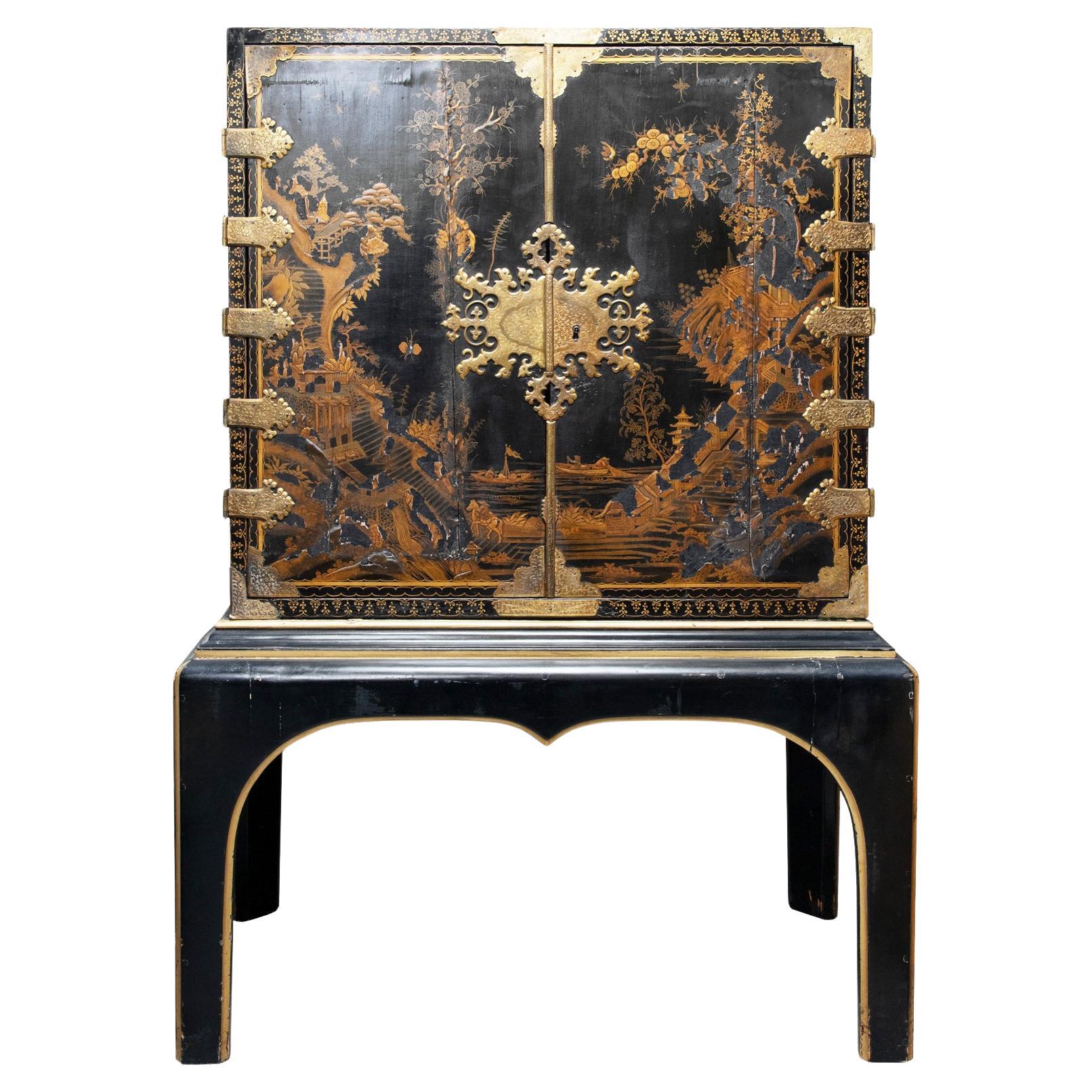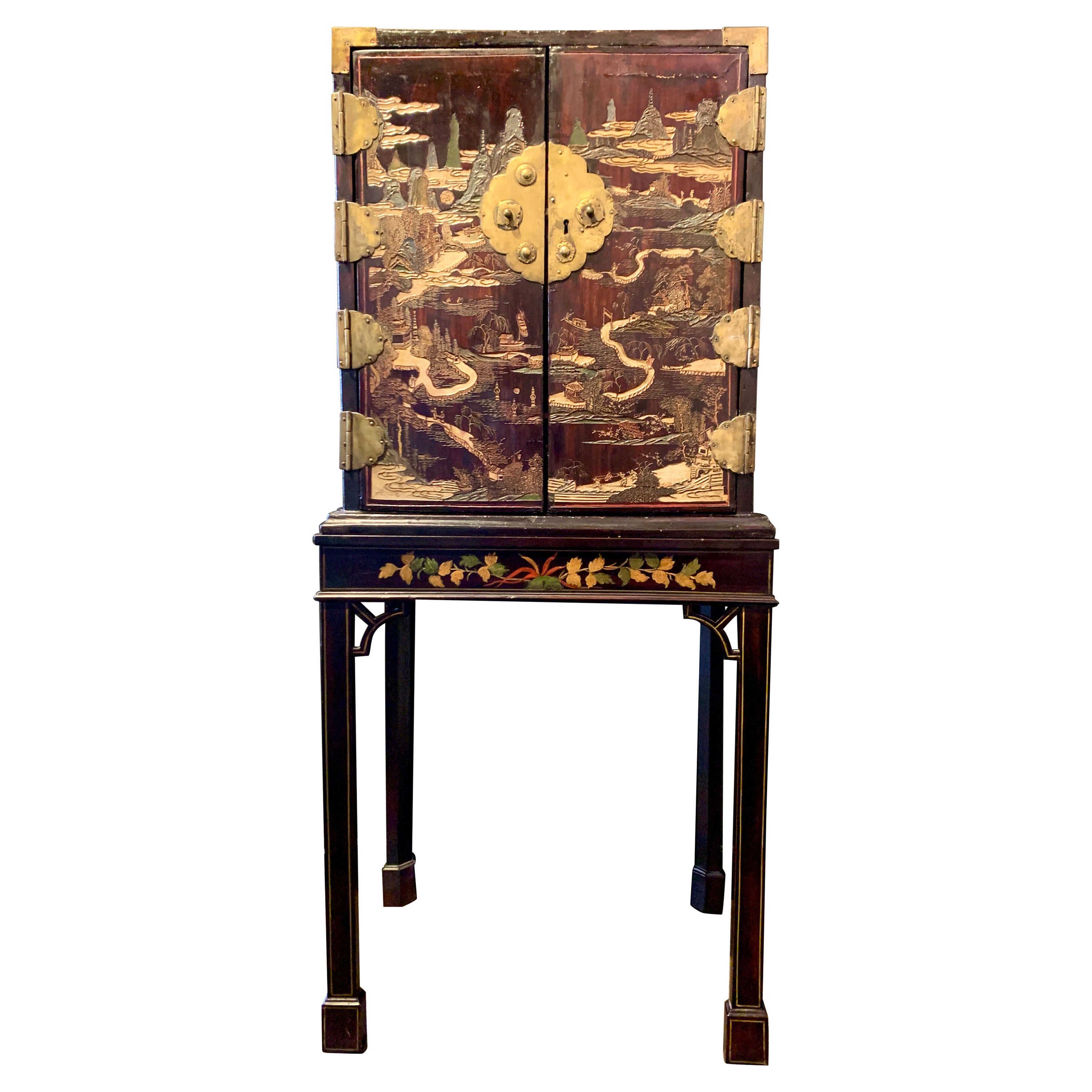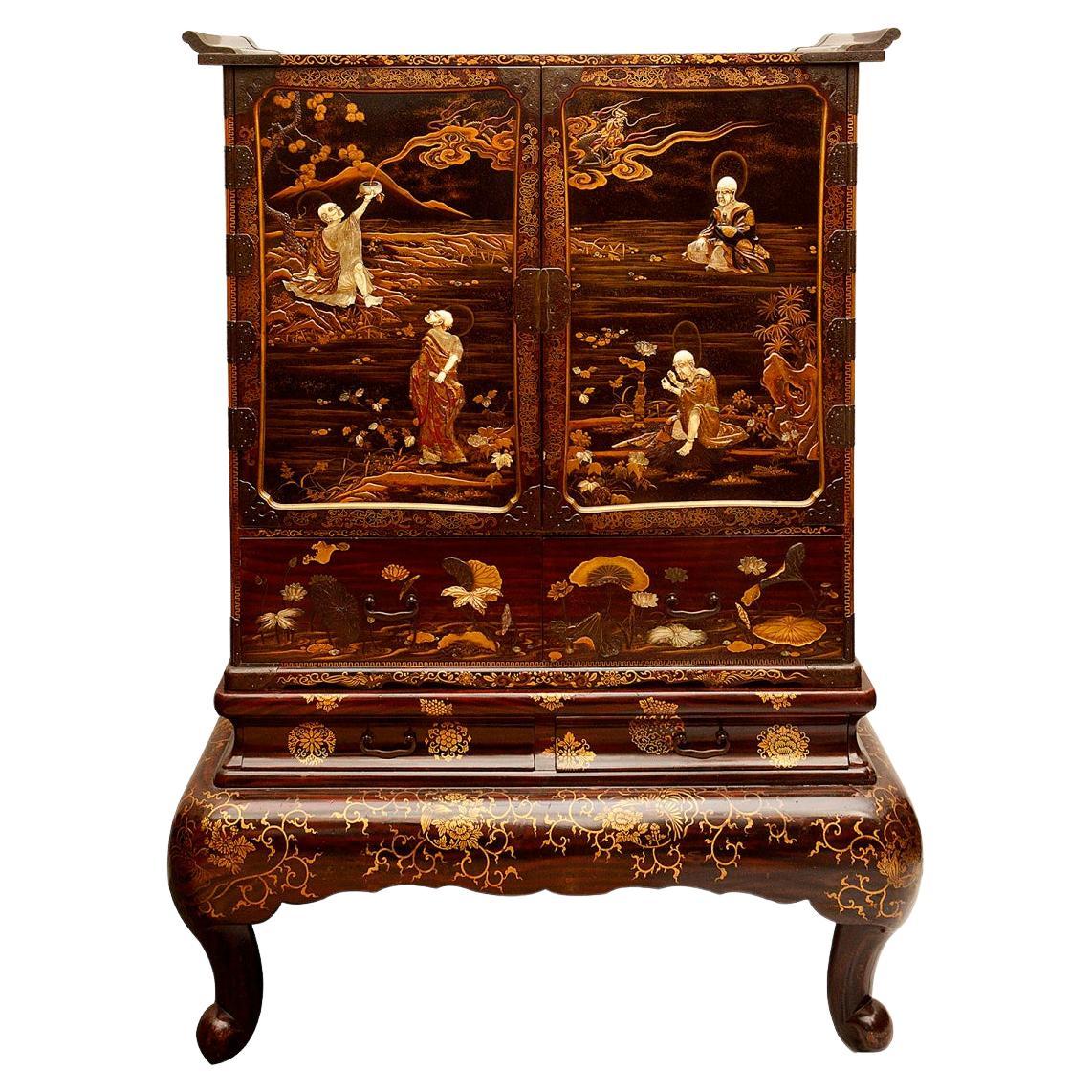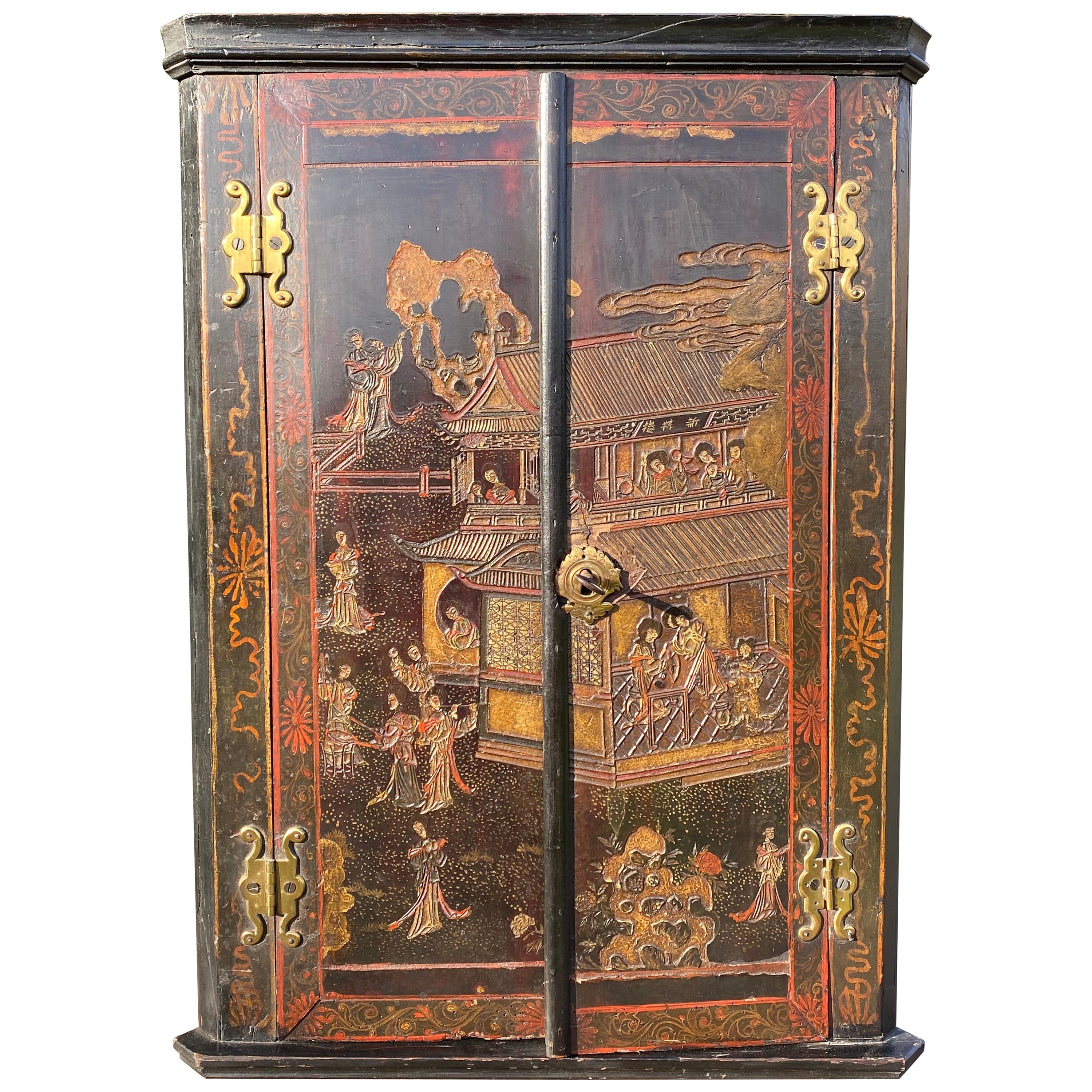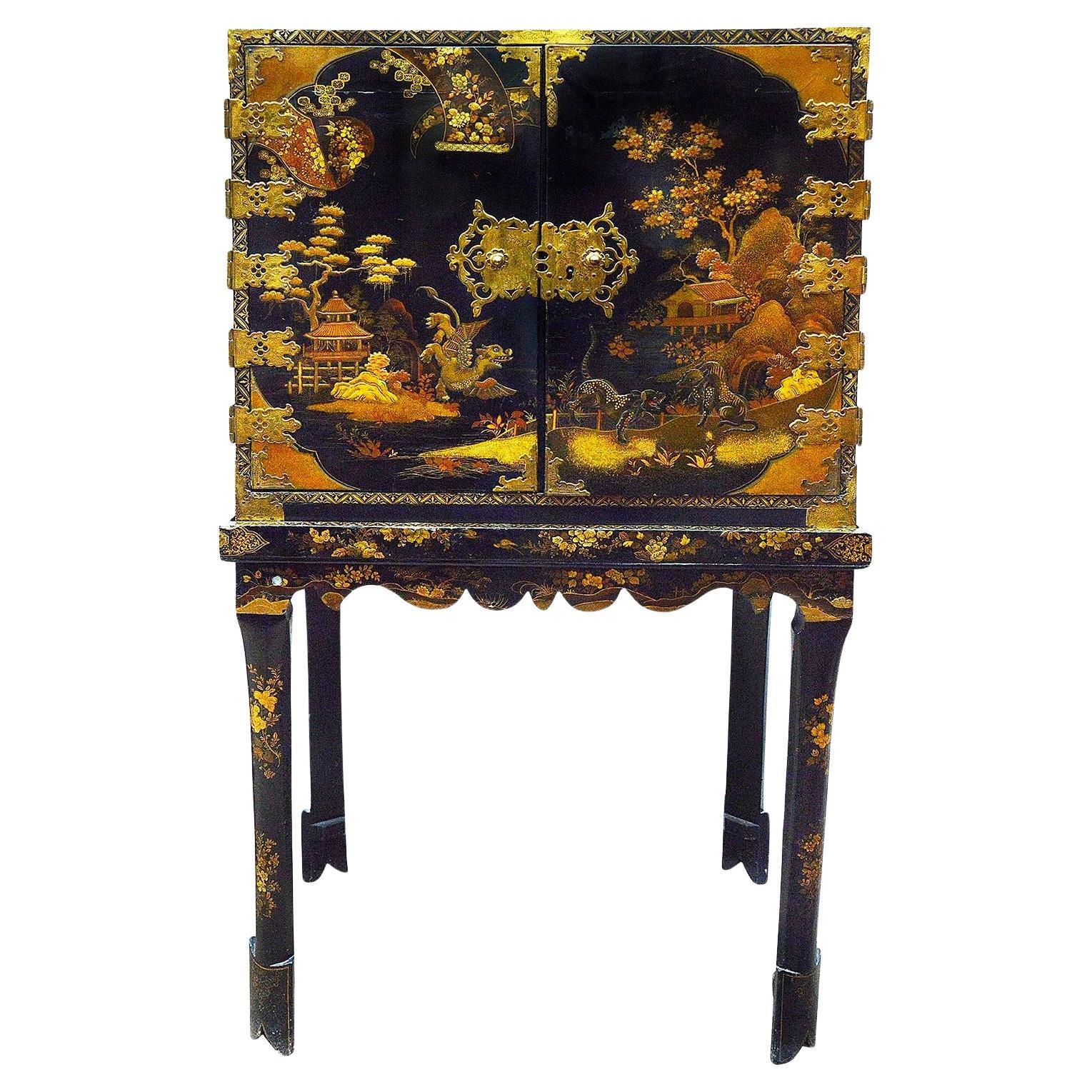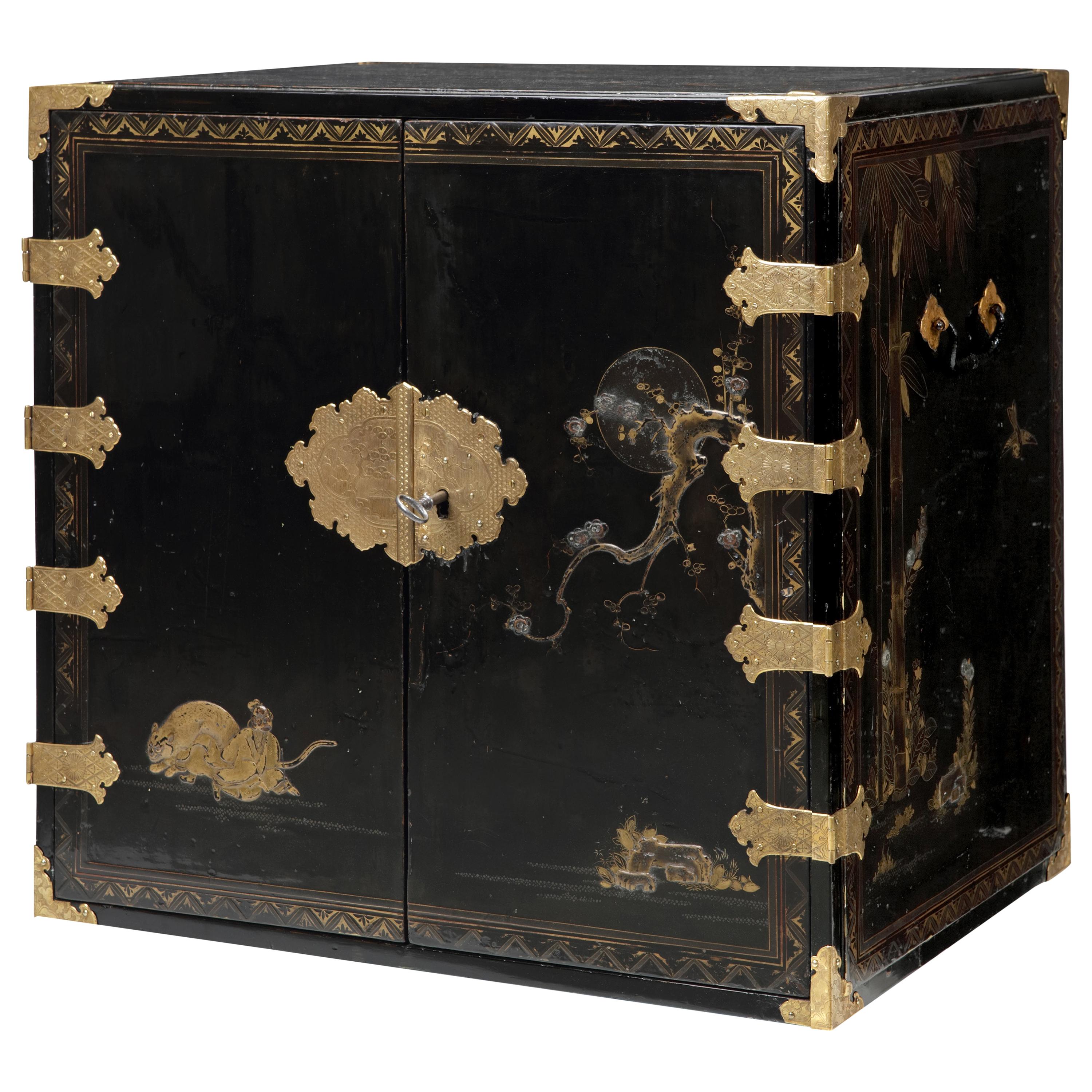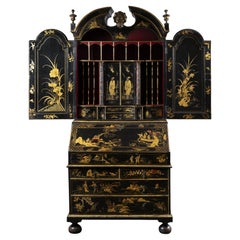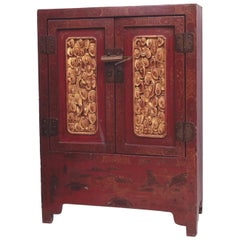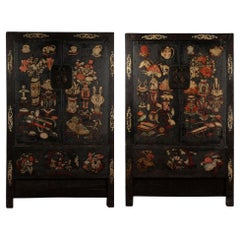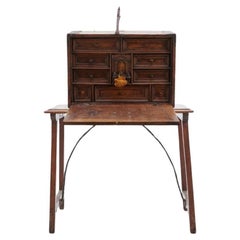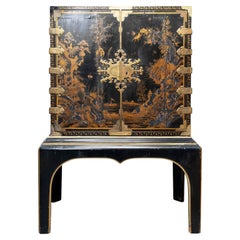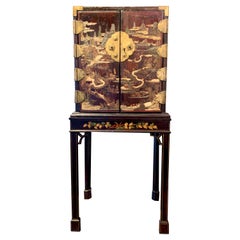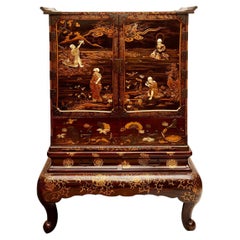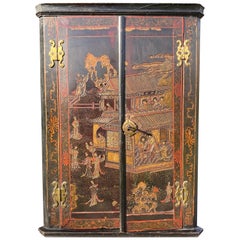Items Similar to George II Lacquered-Brass and Chinese Coromandel Cabinet on Stand, 18th Century
Video Loading
Want more images or videos?
Request additional images or videos from the seller
1 of 12
George II Lacquered-Brass and Chinese Coromandel Cabinet on Stand, 18th Century
$42,000
£31,721.61
€36,660.80
CA$58,911.43
A$65,515.21
CHF 34,294.19
MX$799,205.90
NOK 430,918.99
SEK 405,334.94
DKK 273,649.07
About the Item
A George II Lacquered-Brass and Chinese Coromandel Cabinet on Stand,
Cabinet and stand mid 18th Century, the panels early 18th Century
Provenance:
Walter, 5th Duke of Buccleuch and 7th Duke of Queensberry (d.1884) by 1845.
Thence by descent to the 8th Duke of Buccleuch and Queensbury, K.T.; sold Christie's London, 26th June 1986, lot 129.
Description:
The rectangular lacquered cabinet bearing panels decorated with both avian and botanical scenes of the kuan cai ‘incised colour’ technique, with gilt brass mounts of foliate motif adorning the corners and central edges, the double panelled front centred with conforming brass escutcheon, the two doors opening to reveal interior with twelve drawer compartments. Cabinet is raised on mount with frieze/apron decorated in the style of original panels, the square legs joined by X and ring stretcher.
Dimensions:
Height: 160.5cm
Width: 85.5cm
Depth: 47cm
Notes:
With label detail inscribed 'No.5/Cabinet & Box from/ Duke of Buccleuch/ March 1845' The handwritten inventory labels dating to 1845 are those of Walter, 5th Duke of Buccleuch and the 7th Duke of Queensbury (d.1884). The Duke was heir to the spectacular properties of the Montagu, Douglas and Scott families including Drumlanrig, Dalkeith, Boughton, Bowhill, Adderbury, and Montagu house in London. However, the original commission for this rare 'Bantam' work cabinet has not yet been identified. A late 17th century Coromandel lacquer cabinet on stand bears the same Buccleuch inventory label (numbered 4). The latter was sold as part of collector Simon Sainsbury's celebrated sale, 'Simon Sainsbury: The Creation of an English Arcadia', Christies, London 18th June 2008. That cabinet and the present example both bear lacquer panel that date to the 1680s. The earlier Sainsbury cabinet also retains its late 17th century scroll legged stand. The present cabinet appears to date to the mid-18th century, by virtue of its more refined construction, but using earlier lacquer panels and imitating imported Chinese prototypes; the cabinet appears to be contemporary with the stand. It is interesting to note that while trade records show a decline in the importation of lacquer goods from the late 17th century, Asian lacquer was still considered a luxury good in the second quarter of the 18th century when this piece would have been made. (A. Bowett, Early Georgian Furniture 1715-1740, 2009, pp.42-43). Various Buccleuch ancestors were partial to lacquer furnishings. In the 1670s, Ralph, 1st Duke of Montagu (d. 1709) endevoured to emulate the arts of France while serving as the Kings Ambassador Extraordinary to the Court of Louis XIV. As Keeper of the Kings Great Wardrobe from 1671 and 'Comptroller' of the Royal Tapestry Works at Mortlake from 1674, Monatgu's role was to supervise the purveyors of furnishing to the Royal households and to set the 'national' or 'court; style- and this catapulted his ambition to enlarge both Montagu House and Boughton House in the most fashionable taste expounded by the French court. The early inventories of Boughton reveal a plethora of lacquer furniture - including a Coromandel lacquer dressing table and mirror attributed to Gerrit Jensen. The 1718 inventory also records 'An India Cabinet ', Lady Queensbury's Room - An old India Cabinet' . A coromandel and parcel gilt kneehole dressing table on acanthus-wrapped scrolled legs gilt wood stand was very probably supplied by the same cabinet-maker as the Sainsbury cabinet on stand. Still in the collection of the Dukes of Buccleuch and Queensbury at Bowhill, Scotland, it is certainly conceivable that this is the 'buro made of Japan' referred to on James Morre's bill. Coromandel lacquer or 'Bantamwork', with its incised decoration, was made in Honan province in Northern China from the latter part of the Ming dynasty and exported to Europe from the end of the 17th Century through the East India Company's trading posts on the Coromandel Coast of India. The technique consisted in overlaying a base of wood with a series of increasingly fine white clays and fibrous grasses. Over this surface, lacquer was applied and polished before the design was incised and the hollowed out portions filled with color and gilt and finished with a clear lacquer to protect it. Although John Stalker and George Parker used the term 'Bantamwork', the contemporary laymen usually called it 'cuttwork', 'cutt Japan', or 'hollow burnt Japan'. Stalker and Parker discuss two types of 'Bantamwork' flat and incised. in their 'Treatise on Japanning and Varnishing of 1688, noting that it was 'done in colorus mix't with a gum water'. They also considered that it was 'almost obsolete, and out of fashion, out of use and neglected...' although admitted that 'it was very pretty and some are more fond of it, and prefer it to the other...'
Lot Essay (Christie's)
The handwritten inventory labels dating to 1845 are those of Walter, 5th Duke of Buccleuch and 7th Duke of Queensberry (d.1884). The Duke was heir to the spectacular properties of the Montagu, Douglas and Scott families including Drumlanrig, Dalkeith, Boughton, Bowhill, Adderbury and Montagu House in London – however the original commission for this rare ‘Bantam’ work cabinet has not yet been identified. A late 17th century coromandel lacquer cabinet-on-stand bears the same Buccleuch inventory label (numbered 4). The latter was sold as part of collector Simon Sainsbury’s celebrated sale, ‘Simon Sainsbury: The Creation of an English Arcadia’, Christie’s, London, 18 June 2008, lot 39 (£30,000). That cabinet and the present example both bear lacquer panels that date to the 1680s. The earlier Sainsbury cabinet also retains its late 17th century scroll-legged stand. The present cabinet appears to date to the mid-18th century, by virtue of its more refined construction, but using earlier lacquer panels and imitating imported Chinese prototypes; the cabinet appears to be contemporary with the stand. It is interesting to note that while trade records show a decline in the importation of lacquer goods from the late 17th century, Asian lacquer was still considered a luxury good in the second quarter of the 18th century when this piece would have been made (A. Bowett, Early Georgian Furniture 1715-1740, 2009, pp. 42-43).
Various Buccleuch ancestors were partial to lacquer furnishings. In the 1670s, Ralph, 1st Duke of Montagu (d. 1709) endeavored to emulate the arts of France while serving as the King's Ambassador Extraordinary to the Court of Louis XIV. As Keeper of the King's Great Wardrobe from 1671 and 'Comptroller' of the Royal Tapestry Works at Mortlake from 1674, Montagu's role was to supervise the purveyors of furnishings to the Royal households and to set the 'national' or 'court' style - and this catapulted his ambition to enlarge both Montagu House and Boughton in the most fashionable taste expounded by the French court. The early inventories of Boughton reveal a plethora of lacquer furniture- including a Coromandel lacquer dressing table and mirror attributed to Gerrit Jensen. The 1718 inventory also records 'an India cabinet on a black japanned frame’ which is now untraced. Both the Jensen dressing set and this cabinet are of 'Bantam' or Coromandel incised lacquer - as opposed to flat lacquer or 'japanned' decoration more frequently seen in contemporary Inventories (T. Murdoch et al., Boughton House The English Versailles, London, 1992, pp. 132-133, pl. 78).
In the early 18th century, Anne, Duchess of Buccleuch (d.1732), the daughter-in-law of King Charles II as wife of the Duke of Monmouth, remodelled Dalkeith Palace commissioning japanned furniture from James Moore in 1700-1. An Inventory & Appraisement of Household Furniture at Dalkeith House, taken on 10 March 1812, includes various references to cabinets, including: in the 'Principal Bed Chamber - An India Cabinet', 'Lady Queensberry's Room - An India Cabinet' and 'Lady Queensberry's Sitting Room - An old India Cabinet'. A coromandel and parcel-gilt kneehole dressing table on acanthus-wrapped scrolled legs giltwood stand was very probably supplied by the same cabinet-maker as the Sainsbury cabinet-on-stand. Still in the collection of the Dukes of Buccleuch and Queensberry at Bowhill, Scotland, it is certainly conceivable that this is the 'buro made of Japan' referred to on James Moore's bill.
Coromandel lacquer or 'Bantamwork', with its characteristic incised decoration, was made in Honan province in Northern China from the latter part of the Ming dynasty and exported to Europe from the end of the 17th Century through the East India Company's trading posts on the Coromandel Coast of India. The technique consisted in overlaying a base of wood with a series of increasingly fine white clays and fibrous grasses. Over this surface, lacquer was applied and polished before the design was incised and the hollowed out portions filled with colour and gilt and finished with a clear lacquer to protect it. Although John Stalker and George Parker used the term 'Bantamwork', the contemporary layman usually called it 'cutt-work', 'cutt Japan' or 'hollow burnt Japan'. Stalker and Parker discuss two types of 'Bantam-work' - flat and incised - in their Treatise on Japanning and Varnishing of 1688, noting that it 'was done in colorus mix't with a gum water'. They also considered that it was 'almost obsolete, and out of fashion, out of use and neglected....' although admitted that 'it was very pretty, and some are more fond of it, and prefer it to the other...'
- Dimensions:Height: 63.19 in (160.5 cm)Width: 33.67 in (85.5 cm)Depth: 18.51 in (47 cm)
- Style:George II (Of the Period)
- Materials and Techniques:
- Place of Origin:
- Period:
- Date of Manufacture:Circa 1700s
- Condition:Wear consistent with age and use. Minor losses. Minor structural damages. Minor fading.
- Seller Location:ARMADALE, AU
- Reference Number:Seller: CP/MBSXBS1stDibs: LU8952243680642
About the Seller
5.0
Gold Seller
Premium sellers maintaining a 4.3+ rating and 24-hour response times
Established in 2012
1stDibs seller since 2023
12 sales on 1stDibs
Typical response time: 5 hours
Associations
International Confederation of Art and Antique Dealers' Associations
- ShippingRetrieving quote...Shipping from: ARMADALE, Australia
- Return Policy
Authenticity Guarantee
In the unlikely event there’s an issue with an item’s authenticity, contact us within 1 year for a full refund. DetailsMoney-Back Guarantee
If your item is not as described, is damaged in transit, or does not arrive, contact us within 7 days for a full refund. Details24-Hour Cancellation
You have a 24-hour grace period in which to reconsider your purchase, with no questions asked.Vetted Professional Sellers
Our world-class sellers must adhere to strict standards for service and quality, maintaining the integrity of our listings.Price-Match Guarantee
If you find that a seller listed the same item for a lower price elsewhere, we’ll match it.Trusted Global Delivery
Our best-in-class carrier network provides specialized shipping options worldwide, including custom delivery.More From This Seller
View AllAn English Black Lacquered Chinoiserie Bureau Cabinet, 18th Century
Located in ARMADALE, VIC
An English Black Lacquered Chinoiserie Bureau Cabinet, 18th Century
Description:
The upper section with a breakfront arched pedimental cornice flanked by a pair of urn finials, over...
Category
Antique 18th Century English Chinoiserie Cabinets
Materials
Wood
$38,500 Sale Price
30% Off
A Pair of Chinese Gilded and Lacquered Cabinets, Qing Dynasty
Located in ARMADALE, VIC
A Pair of Chinese Gilded and Lacquered Cabinets, Qing Dynasty
Rectangular, decorated with bat and cloud motif to body, with gilded and relief car...
Category
Antique 19th Century Chinese Qing Furniture
Materials
Hardwood
Pair of Chinese Black Lacquered Polychrome Wedding Cabinets, Early 20th Century
Located in ARMADALE, VIC
A Pair of Chinese Black Lacquered Polychrome Wedding Cabinets, Early 20th Century
Description:
Feature intricate hand-painted designs depicting scenes of courtly life, floral motifs, and auspicious symbols like vases and pomegranates, which represent fertility and blessing.
Provenance: Private Australian Collection.
Dimensions:
Height: 188.5cm.
Width: 118cm.
Depth: 50cm.
Significance:
Traditionally, such cabinets were given as part of a bride's dowry and were used to store valuable items like fabrics and silks.
Construction:
Made from solid wood, finished with a durable lacquer, these cabinets showcase the skilled craftsmanship prevalent in Chinese furniture making during that era.
Symbolism:
The painted motifs, such as plum blossom and peony, carry symbolic meanings within Chinese culture, adding to the cultural richness of these pieces.
Collectibility:
Antique Chinese wedding cabinets...
Category
Early 20th Century Chinese Furniture
Materials
Wood, Lacquer
A Spanish Walnut Vargueno with Base, 18th Century
Located in ARMADALE, VIC
A Spanish Walnut Vargueno with Base, 18th Century
Provenance: Private Australian Collection.
Description: ...
Category
Antique 18th Century Spanish Cabinets
Materials
Iron
$15,500 / set
An Italian Painted Bookcase, Late 19th Century
Located in ARMADALE, VIC
An Italian Painted Bookcase, Late 19th Century
Home decor and Interior design.
Provenance: Private Australian Collection.
Dimension:
Height...
Category
Antique Late 19th Century Italian Wardrobes and Armoires
Materials
Wood
A George I Walnut Bureau Cabinet, Early 18th Century
Located in ARMADALE, VIC
A George I Walnut Bureau Cabinet, Early 18th Century
Provenance: Priva...
Category
Antique 18th Century English George I Cabinets
Materials
Walnut
You May Also Like
Early 18th century Japanese Lacquer Cabinet on Stand
Located in Rīga, LV
Rectangular cabinet has nine drawers inside. Hinges, corner mounts and lock plates in gilt brass. Decorated with river landscapes, insects, birds and animals in pairs. The stand is i...
Category
Antique Early 18th Century English George III Cabinets
Materials
Wood, Lacquer
Chinese Export Coromandel Lacquer Cabinet on Stand, Mid-19th Century, China
Located in Austin, TX
A delightful Chinese coromandel brown lacquer cabinet on stand, made for the export market, early to mid-19th century, China, presented on an early 20th century custom fitted stand.
The gem of a cabinet is fitted with doors and drawers, and decorated on all sides.
The top, back and sides with lacquer painted scenes of birds and flowers.
The front of the cabinet featuring a pair of stunning coromandel doors carved with a shanshui (mountain and water) landscape scene, complete with temples and pagodas, boats and bridges, and figures, all set against craggy mountains shrouded in clouds and rippling water.
The cabinet mounted with brass hinges and lock plates (key included) and a pair of carrying handles.
Opening the doors reveals eleven wondrous black lacquer drawers...
Category
Antique Mid-19th Century Chinese Chinese Export Furniture
Materials
Brass
Japanese Lacquer Meiji Period Cabinet on Stand, circa 1890
Located in Brighton, Sussex
A exquisite, fine quality Meiji period (1868-1912) Japanese black lacquer cabinet on stand with wonderful scrolling gilded decoration. H...
Category
Antique Late 19th Century Japanese Japonisme Lacquer
Materials
Lacquer
Early 18th Century Coromandel Lacquer Corner Cabinet
Located in Lymington, GB
An early-18th century Coromandel lacquer corner cupboard or cabinet.
This is rare - high quality Coromandel lacquer work (incised decoration) - not to be confused with the usual English japanned versions.
This is also referred to as Bantam work, originating in Bantam, Dutch East Indies, and China, for export to the European market.
The subject matter is of a major pavilion with numerous courtiers - most unusual to see only females - it has been suggested that they may be concubines to a Mandarin.
All of high quality and in the sought-after and refined chinoiserie taste.
In very good unrestored state, retaining vibrant colours and all its original hardware. This is a chic antique, and makes a lovely chinoiserie drinks cabinet...
Category
Antique Early 18th Century Asian Cabinets
Materials
Lacquer
18th Century Queen Anne Lacquer cabinet on stand.
Located in Brighton, Sussex
A beautifully decorated Queen Anne period lacquer cabinet on stand. Having pierced, fretted brass hinges and lock plates. Chinoiserie scenes to the doors, opening to reveal ten fitte...
Category
Antique 18th Century English Cabinets
Materials
Lacquer
Rare Charming 17th Century Japanese Lacquer Cabinet with Gilt-Bronze Mounts
Located in Amsterdam, NL
A fine Japanese pictoral style lacquer cabinet with gilt-metal mounts
Kyoto, Edo period, 1670-1690
Decorated in Japanese relief lacquer work, black lacquer ground decorated...
Category
Antique Late 17th Century Japanese Furniture
Materials
Bronze
$44,697 Sale Price
25% Off
Free Shipping
More Ways To Browse
Chinese And England
French Lacquer Cabinet
King George Furniture
Used Cabinet Bed
Record Stand
Black Chinese Mirrors
White Lacquer Box
Wood Overlay
18th Century Scotland
English China Sets
Lacquer Box France
18th Century French Corner Cabinet
18Th Century Mirrored Cabinet
Old Antique Corner Cabinet
Chinese Black Lacquer Cabinet
Antique Coromandel
Japanese Mid Century Cabinets
Scotland Brass
